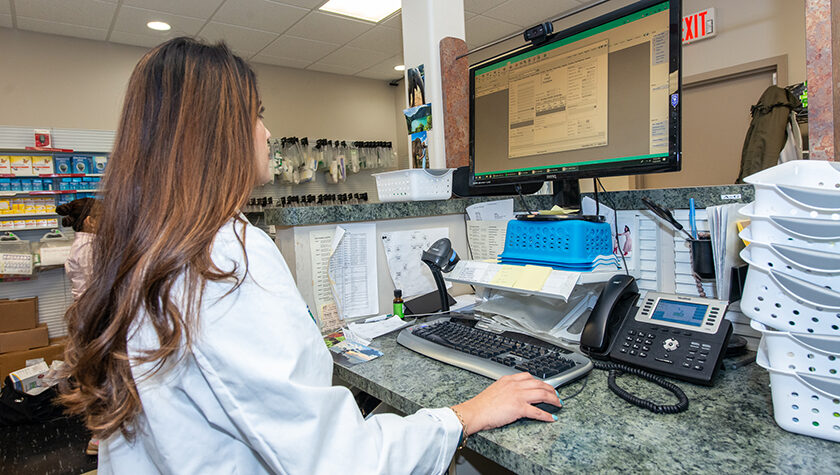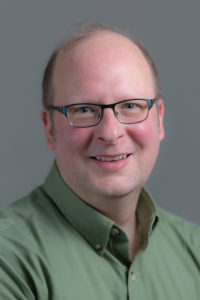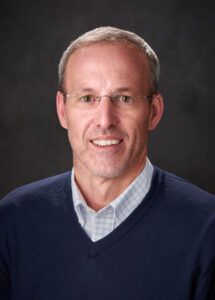
5
December

School of Pharmacy researchers examine the barriers and benefits of community pharmacists gaining access to patients’ health histories
By Mary Magnuson
From hospitals to long-term care facilities to community clinics, pharmacists analyze and double-check prescriptions, promote the safe use of medications, and function as affordable and accessible healthcare providers for many people. They’re the last point of contact a patient with a prescription will have — and, armed with specialized expertise in medications, they’re the last line of defense in ensuring each prescription is accurate and appropriate.
Yet pharmacists in Wisconsin, and nationwide, are without access to information about patients’ electronic health records (EHRs).
“It’s difficult to treat someone if you don’t know the patient’s health history and information,” says Aaron Gilson, a scientist in the University of Wisconsin–Madison School of Pharmacy’s Sonderegger Research Center for Improved Medication Outcomes.
“Currently, pharmacists only have access to patients’ medication profiles maintained by the dispensing pharmacy. But if they knew why the person was prescribed a medication, if they had the clinical context for those prescriptions, then it would allow them to make decisions about whether they need to follow up with the prescriber about certain issues,” he says.
“There was an acknowledgment from everyone, both health information managers and pharmacists, that pharmacist involvement in patient care through EHRs is very important for the care of that patient.”
—David Mott
Permission to view these records is just one facet of the issue, says Professor David Mott, chair of the School’s Social and Administrative Sciences Division. Access is further complicated by the fact that community pharmacies don’t have software that can seamlessly integrate the EHR information into their dispensing software.
Through a grant from the Community Pharmacy Foundation, Mott and Gilson set out to learn how Wisconsin pharmacists could gain access to this information and how pharmacists who already have access are using it to improve patient care.
Identifying the gap
EHRs contain a patient’s past diagnoses, summaries of clinic visits, X-ray records, and more. Pharmacists working within a health system — for example UW Health or Group Health Cooperative pharmacists — can view EHRs within their system, but external pharmacies cannot.
“Pharmacists who work in a hospital or in the clinics will have access to that EHR, so they can have access to the patient information when they’re, for example, dosing medications or clarifying orders,” says Gilson. “However, pharmacists out in the community are isolated from the rest of the healthcare system, because there’s nothing that connects them with information about a patient.”

Mott and Gilson launched their research project with three aims, two of which were to conduct interviews with personnel from both sides of the access issue: health information managers, or EHR administrators from health systems in the state, and community pharmacists in Wisconsin with EHR access. The third aim was to create a toolkit focused on how to access and use EHRs.
Some pharmacies, generally on a one-off basis, have formed symbiotic relationships with health systems and have gotten connected to their EHRs. But to Mott and Gilson’s surprise, that’s a rarity within the field: They were able to find three such pharmacists to interview. Of the five EHR administrators they spoke with, only one worked at a health system that granted access to a group of external pharmacists.
“We thought that more health systems were allowing access to community pharmacists to the EHR, and thus more community pharmacists had access to an EHR,” Gilson says. “We were surprised to learn how limited it really was and how few health systems were providing access.”
Mott says that all of the four health information managers they spoke to whose health system didn’t allow EHR access by community pharmacists were interested in forming those relationships. But they weren’t seeing any demand from pharmacists, revealing a communication gap.
“There was an acknowledgment from everyone, both health information managers and pharmacists, that pharmacist involvement in patient care through EHRs is very important for the care of that patient,” Mott says. “But there was also a recognition that the demand for that access isn’t there.”
That proved the biggest takeaway, Mott says: Community pharmacists want access, and health information managers want to give it to them. But neither is quite sure how to develop the systems necessary to bridge that gap.
Even though there may be challenges ahead — such as pharmacies migrating to different software or modifying what they already use to connect to health systems — Gilson says its inspiring to see the commitment of the pharmacists who have moved forward accessing EHRs.
“It was enlightening to talk with pharmacists who already have access to the EHR and hearing how they’re utilizing it,” Gilson says. “Understanding the struggles that they’re having is also valuable. We need to learn from the pioneers in this area.”
Moving forward
Mott and Gilson plan to write up some of the results of their interviews, and then communicate these results to stakeholders in the field, including health system administrators and community or independent pharmacy managers.

Gilson says their results indicate that, although everyone involved wants pharmacists to have the resources they need, the bigger question is how to get it to them.
“We also need to start talking about what the pharmacy profession needs to do strategically to send a message or to communicate to health systems and providers,” Mott says. “There are some anecdotal stories and articles that have been published, but there’s really nothing on a larger level about the policies, procedures, barriers, and facilitators for EHR access.”
But alongside raising awareness about the EHR issue, Mott says they also need to keep studying this research topic. This study was a shallow dive with a few interviews to understand the scope of the access issue and what future studies would need to look like. Uncovering this communication gap is just the tip of the iceberg.
Although Mott and Gilson had initially set out to create a toolkit to help community pharmacists access EHRs, after this pilot study, they chose to take a step back and reevaluate how best to communicate their results.
Instead of making a toolkit for individual pharmacists, they decided to focus on large-scale reports they can use to facilitate broader conversations about EHR access within pharmacy as a field.
Right now, they are drafting their report to go back to the Community Pharmacy Foundation, but Mott wants to go a step further and present this research to pharmacists across the state. Once they’ve opened a wider dialogue, they can begin planning their next steps for deeper research.
“This is not enough,” Mott says. “There’s a lot more that needs to be done in order to really provide valuable and relevant information. We need to learn more from early adopters, on both sides, about best practices, barriers, and facilitators to develop communication strategies and processes to facilitate broader EHR access.”




